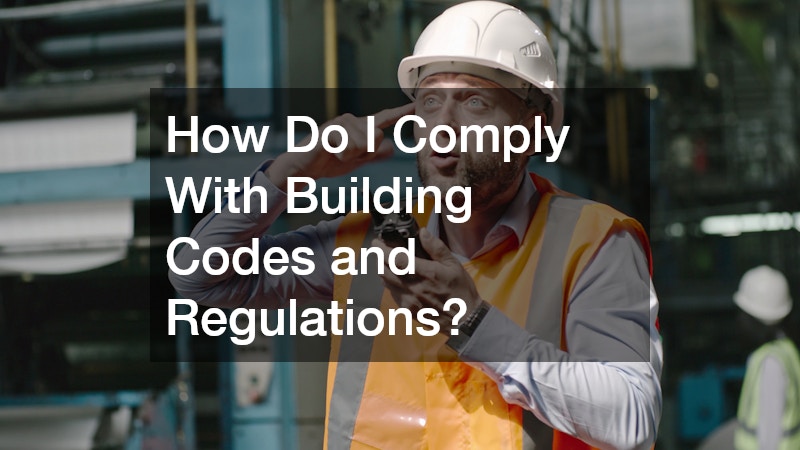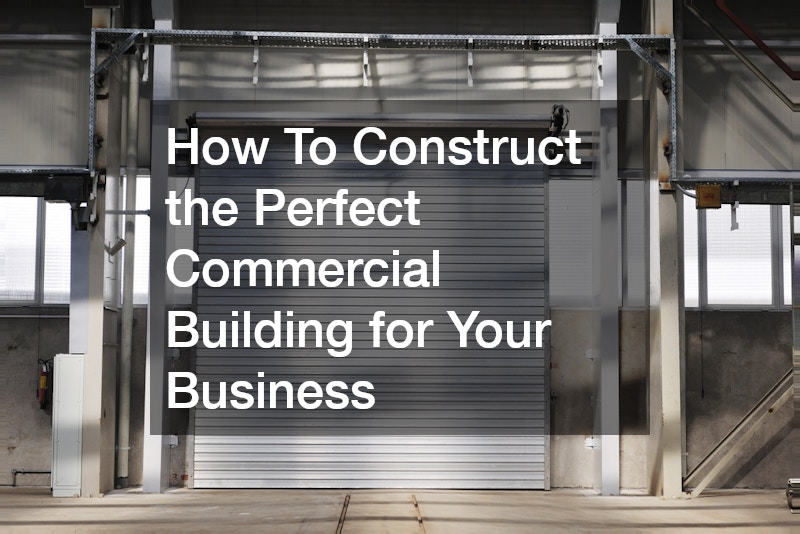
Constructing the ideal commercial building for your business requires strategic planning, thoughtful design, and careful execution. Whether you’re developing a new headquarters, opening a storefront, or establishing a warehouse, each decision you make—from location to layout—has lasting implications on efficiency, branding, and profitability. In this guide, we’ll walk through the most critical phases of the process to help you build a space that not only meets your operational needs but also sets the foundation for long-term success.
What Is the Best Location for My Commercial Building?

Analyzing Market Demographics
A strong location strategy begins with analyzing the customer base. Review data on age, income, and consumer behavior to make sure the site you choose aligns with your business model. If you’re engaging in build to suit development, where the building is customized to meet your operational goals, a clear understanding of your target demographic ensures the investment supports foot traffic and client engagement.
Evaluating Accessibility and Transportation
Transportation access plays a vital role in determining how easily clients, vendors, and employees can reach your building. A convenient location near major roadways, bus lines, or train stations increases accessibility. If you rely on vehicle traffic, consider proximity to arterial routes and invest in parking lot paving to maximize convenience and safety for users.
Considering Future Growth
Commercial sites should offer flexibility for future expansions. Think about potential growth and whether the property and surrounding infrastructure can accommodate it. This is especially important for businesses choosing metal building construction, which offers modularity and adaptability for future space additions.
Understanding Zoning Laws
Zoning regulations affect how your building can be used. Before breaking ground, verify that the property is zoned appropriately for your intended use. If you’re planning operations that include warehousing or fabrication, check for industrial zoning allowances. Engaging with a fence contractor early can also help define property boundaries according to municipal guidelines.
Examining Local Competition
Understanding the presence of competitors near your potential location helps gauge market saturation. In retail-heavy zones, consider how your commercial siding design and storefront layout can visually differentiate your brand while fitting the area’s commercial character.
How Do I Set a Realistic Budget?
Estimating Construction Costs
Initial budgeting should reflect every cost from excavation to finishing. Whether you’re planning flat roof installs or choosing high-performance commercial insulation, consult local vendors and contractors to assess current material and labor rates. Don’t forget to include specialty services like commercial garage doors or technology infrastructure installation.
Identifying Hidden Costs
Unanticipated expenses are common in commercial construction. Site grading, utility upgrades, or stormwater management systems often get overlooked in early estimates. If you plan on working with commercial flooring companies to install durable, high-traffic surfaces, remember that subfloor prep and specialty adhesives can significantly increase costs.
Creating a Contingency Fund
A financial cushion—ideally 10 to 20 percent of your total budget—helps absorb cost overruns, permitting delays, or design changes. This buffer becomes especially valuable if you encounter complications with custom components like metal building construction or specialized commercial siding.
Financing Options and Considerations
Explore construction-specific loans, lease-back agreements, or SBA loans tailored to small and medium-sized businesses. In many cases, build-to-suit development arrangements offer favorable financial terms, allowing you to occupy a property custom-designed for your operations while preserving capital.
Working with a Financial Advisor
A qualified financial advisor helps structure your budget to support long-term profitability. They’ll evaluate whether to purchase materials outright or stagger investments, such as choosing basic roofing now with the option to upgrade through a trusted roofing company later.
How Do I Choose the Right Architect and Builder?

Defining Your Project Needs
Before hiring professionals, clearly define what the building needs to do. Should it be optimized for heavy machinery? Do you need large bays for commercial garage doors? Should your roofing company prepare the structure for solar panel installation? Having answers helps professionals provide more accurate bids and better design strategies.
Researching and Shortlisting Professionals
Look for firms with experience in commercial spaces similar to yours. Builders with a background in flat roof installs or metal building construction are particularly valuable if you need scalable, industrial-strength structures. Don’t hesitate to ask about their familiarity with your local building codes.
Checking References and Portfolios
Request references from similar commercial projects. If possible, tour buildings they’ve constructed—especially those using specialized materials like commercial insulation or commercial flooring solutions—to evaluate build quality and durability over time.
Understanding Contracts and Agreements
Review contracts carefully for payment schedules, deliverables, and timelines. If you’re using multiple contractors—say, one for parking lot paving and another for fence construction—clarify who holds responsibility for site coordination and compliance.
Ensuring Clear Communication
A seamless project requires communication among all stakeholders. Builders, architects, your roofing company, and subcontractors like commercial flooring companies or siding installers should collaborate with you through a centralized communication plan to prevent misunderstandings.
What Are the Essential Design Features to Consider?
Designing for Functionality and Flow
Every inch of your building should contribute to productivity. Whether it’s wide corridors for inventory movement or strategic door placement for easy access to commercial garage doors, design for how people and goods flow through the space.
Emphasizing Natural Light and Ventilation
Skylights, clerestory windows, and operable systems improve indoor air quality and reduce lighting expenses. Ventilation is especially critical in metal building construction, which can trap heat without proper insulation and airflow design.
Incorporating Sustainable Practices
Green building features—like energy-efficient HVAC, solar-ready flat roofs, or sustainable flooring—enhance your environmental profile and lower long-term operational costs. Choose a roofing company that offers reflective membranes or green roofing options for improved performance.
Planning for Technological Integration
Your building must accommodate current and future technology needs. Plan for wiring, server rooms, and digital display systems. Leave access panels in floors or ceilings to simplify future upgrades without disrupting commercial flooring or ceiling finishes.
Considering Accessibility for All
Compliance with ADA standards isn’t just legally required—it also promotes inclusivity. Ensure doorways, restrooms, parking spaces, and entry ramps meet or exceed accessibility standards. A smooth transition from the paved parking area to entry points is especially important.
How Do I Ensure Energy Efficiency in My Building?
Evaluating Energy-Saving Technologies
Incorporate automated lighting, smart thermostats, and sensor-based HVAC systems. Many commercial HVAC systems integrate seamlessly with building automation platforms, delivering both comfort and savings.
Investing in Quality Insulation
Commercial insulation prevents energy loss, reduces noise, and enhances overall comfort. Discuss R-value requirements with your builder to ensure walls, ceilings, and floors meet regional energy codes. Spray foam, fiberglass batts, and rigid foam boards each offer distinct advantages.
Utilizing Energy-Efficient Lighting
Switch to LED fixtures with occupancy sensors. In commercial buildings, lighting is often one of the largest energy expenses. LED retrofits in large, open areas—like warehouses or showrooms—pay for themselves quickly through reduced power bills.
Implementing Smart Systems
Use software to monitor building performance in real-time. From controlling commercial garage doors to adjusting HVAC settings remotely, smart systems provide operational control and help identify inefficiencies.
Conducting Regular Energy Audits
Schedule professional energy assessments to uncover inefficiencies. Auditors can evaluate your roofing insulation, HVAC performance, and even how well your commercial siding contributes to thermal regulation.
How Do I Comply With Building Codes and Regulations?

Understanding Local Building Codes
Regulations vary by municipality, and ignorance is costly. Confirm that your construction plan addresses all local ordinances regarding structural safety, occupancy limits, and emergency access points.
Meeting Safety Standards
Fire exits, sprinkler systems, and clear access paths must be part of your design. Make sure these elements are well-integrated with your interior layout and reviewed by relevant authorities.
Obtaining Necessary Permits and Approvals
Permitting can be complex—especially if you’re incorporating services like commercial flooring companies or metal building construction that require specialty inspections. Work with an experienced project manager or local architect to ensure everything is submitted properly.
Staying Updated on Regulatory Changes
Building codes evolve. Stay informed about changes to fire safety, energy efficiency, or ADA compliance. Partner with a roofing company or contractor who actively monitors industry standards to help you stay ahead.
Conducting Compliance Checks
Before occupancy, conduct walkthroughs to ensure every system—from flat roof drainage to fence placement—is installed correctly and compliant with regulations.
What Are the Key Stages of the Construction Process?
Site Preparation and Planning
Initial work includes land clearing, grading, and installing utilities. If you’re using build-to-suit development, collaboration with your general contractor from the outset ensures the lot is prepped to match your operational specifications.
Foundation and Structural Framework
Once the site is ready, construction of the foundation begins, followed by structural steel erection or framing. In metal building construction, prefabricated parts speed up this phase significantly.
Installing Systems (Plumbing, Electrical, HVAC)
Next comes infrastructure—wiring, ductwork, drainage, and gas lines. Commercial insulation is typically installed during this stage to optimize temperature and acoustic performance.
Interior and Exterior Finishing
Drywall, paint, commercial flooring, and millwork bring interiors to life. Exterior elements like commercial siding and parking lot paving enhance curb appeal and functionality.
Final Inspections and Handover
Before the handover, all systems undergo inspection. Any deficiencies must be corrected. Only after passing final checks can your certificate of occupancy be issued.
How Do I Manage the Construction Timeline?
Setting Realistic Milestones
Break down the project into phases—each with clear objectives and deadlines. Include buffer time for delays caused by weather, permitting, or material shortages.
Coordinating With Contractors and Suppliers
Keep all teams aligned using regular status meetings. From the fence contractor to the commercial garage door installer, clear timelines reduce miscommunication and bottlenecks.
Monitoring Progress and Adjustments
Use daily or weekly reports to track progress. If part of the project—like flat roof installs—falls behind, take early action to reallocate resources.
Addressing Delays and Challenges
Delays are inevitable. Keep flexible with scheduling and lean on experienced contractors who know how to pivot without sacrificing quality.
Using Project Management Tools
Digital platforms help track budgets, delivery schedules, and contractor updates in real time. Cloud-based tools improve visibility for stakeholders and allow remote approvals or changes.
How Should I Design the Interior of My Commercial Building?
Aligning With Business Objectives
Your interior layout should reflect your core mission. For a client-facing company, aesthetics and comfort may matter most. For logistics or fabrication businesses, operational flow takes precedence.
Choosing Appropriate Materials and Finishes
Durable, attractive finishes strike a balance between style and functionality. Consult with commercial flooring companies to choose materials that withstand wear while enhancing design appeal.
Creating a Welcoming Atmosphere
Use thoughtful color schemes, lighting, and signage to create a space that’s inviting. Your commercial siding and entry design contribute to first impressions before visitors even walk inside.
Implementing Flexible Space Solutions
Design with reconfiguration in mind. Modular furniture, mobile partitions, and multi-use rooms accommodate growth, remote work, and evolving workflows.
Prioritizing Employee Comfort and Productivity
A comfortable environment boosts morale and output. Prioritize ergonomic furnishings, daylight access, quiet zones, and climate control systems.
What Post-Construction Activities Should I Consider?

Setting Up Maintenance Protocols
Create a plan for upkeep, covering HVAC, roofing, plumbing, and commercial flooring. Preventive maintenance extends the life of your investment.
Scheduling Regular Inspections
Annual assessments of structural elements, parking lot paving, commercial siding, and commercial insulation help you identify issues before they escalate.
Gathering Feedback for Future Improvements
Engage employees, tenants, or clients to gather feedback. Use their insights to make adjustments that improve functionality and satisfaction.
Celebrating and Marketing Your New Space
Host a launch event or open house to generate buzz. Highlight your build-to-suit development process in marketing campaigns to show how your new building is tailored for excellence.
Reviewing Long-Term Business Goals
Now that construction is complete, evaluate how the building supports your five- or ten-year vision. Whether it’s adding solar panels or expanding facilities, keep your next move in sight.
Final Thoughts
Constructing the perfect commercial building requires much more than materials and manpower—it requires vision, diligence, and strategic decision-making. From finding the right location to working with experts in flat roof installs, commercial insulation, and commercial flooring, each step builds upon the last to create a space that propels your business forward. With proper planning, the result will not just house your business—it will elevate it.

